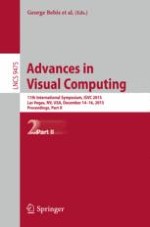The two volume set LNCS 9474 and LNCS 9475 constitutes the refereed proceedings of the 11th International Symposium on Visual Computing, ISVC 2015, held in Las Vegas, NV, USA in December 2015.
The 115 revised full papers and 35 poster papers presented in this book were carefully reviewed and selected from 260 submissions. The papers are organized in topical sections: Part I (LNCS 9474) comprises computational bioimaging; computer graphics; motion and tracking; segmentation; recognition; visualization; mapping; modeling and surface reconstruction; advancing autonomy for aerial robotics; medical imaging; virtual reality; observing humans; spectral imaging and processing; intelligent transportation systems; visual perception and robotic systems. Part II (LNCS 9475): applications; 3D computer vision; computer graphics; segmentation; biometrics; pattern recognition; recognition; and virtual reality.
